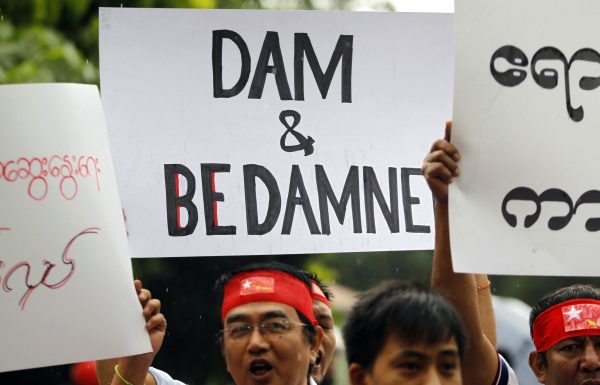The Myitsone dam is a huge Chinese investment aimed at generating a capacity of 6,000 megawatts, 90 per cent of which is for distribution in Yunnan Province. To make way for it, thousands of local residents were resettled — an event that has greatly contributed to the formation of anti-Chinese sentiment in Kachin State.
Following a bilateral agreement between Beijing and Naypyidaw, construction was started in December 2009 by China Power Investment — a Chinese state-owned enterprise — that would operate the dam for 50 years before transferring it to Myanmar. On 30 September 2011, then president Thein Sein temporarily suspended the project until the end of his mandate. The new government de facto led by Aung San Suu Kyi has not yet decided whether to definitively stop or to resume the project. An ad hoc commission submitted a preliminary report in November 2016, but it is still yet to produce its final assessment.
Although official records of Myanmar’s President Htin Kyaw’s visit to Beijing last April are silent on the matter, the Myitsone dam must have been part of the discussion. This was not ruled out by the Chinese Foreign Affairs Ministry, affirming China’s willingness ‘to properly address problems and difficulties in the spirit of cooperation’. Further, China’s Vice Foreign Minister Liu Zhenmin reportedly declared that ‘in a not so distant future there might be a settlement proposal acceptable to both parties’.
Indeed, Reuters had reported Beijing’s readiness to scrap the project in exchange for small hydropower plants and preferential access to the deep sea port of Kyaukphyu on the Bay of Bengal. The same source notes that because of the economic slowdown in Yunnan and the consequential overcapacity in energy production, the Myitsone dam would lose some of its importance. Nevertheless, media speculation that China might simply give up on Myitsone was immediately refuted by a Foreign Affairs Ministry spokeswoman, who declared that China’s position on the issue ‘has not changed’.
While officials remain tight-lipped, Chinese scholars have long argued that saving the Myitsone project might be practically impossible. Back in early 2016, Lu Guangsheng and Huang Dekai from the influential Institute for Southeast Asian Studies at Yunnan University wrote that restarting the project would be extremely unlikely in the short term — the project’s arrest had become a ‘symbol of democratisation’ in the country. Indeed, for Zhao Yi of the PLA National Defence University, such a long suspension of construction work is ‘tantamount to cancellation’.
According to Li Chenyang, an authority among Chinese scholars of Myanmar, by August 2016 the two parties had already reached a ‘tacit agreement’ that Myitsone would no longer complicate bilateral relations. Li also reports that China’s Ambassador to Myanmar Hong Liang openly declared that if the project were eventually cancelled, the Chinese investor would consider requesting preferential treatment in other projects in place of full compensation. With Myanmar as an important target of China’s ambitious Belt and Road Initiative (BRI), there is plenty of room for manoeuvre in this respect.
China knows that the collaborative rhetoric surrounding BRI must be grounded first in collaborative relationships with its neighbours. Myanmar is a crucial test case for Beijing’s credibility as a reliable and constructive partner.
Further, after Myanmar’s opening up, other partners (especially India and Japan) are now part of the game and there is room for Naypyidaw to hedge in the event of Chinese obstinacy. Though China is still Myanmar’s largest investor and trade partner, and the Bangladesh–China–India–Myanmar corridor is one of the six corridors in the BRI.
For Beijing, it would be better to damn a dam conceived in the old junta times than to risk losing these golden opportunities in Myanmar’s new semi-democratic era.
Giuseppe Gabusi is Professor of IPE and Political Economy of East Asia at the University of Turin. He is a co-founder of the Torino World Affairs Institute (T.wai), where he heads the Program ‘Changing World Politics’ and edits RISE, an online quarterly on contemporary South East Asia.
Simone Dossi is a Postdoctoral Fellow at the Department of International Legal, Historical and Political Studies, University of Milan, and a Research Fellow at T.wai.

